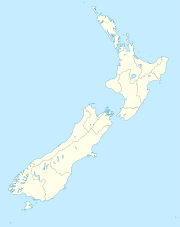Te Awamutu
| Te Awamutu | |
|---|---|
| Town | |
| Nickname(s): T.A., "The Rose Town of New Zealand" | |
| Location of Te Awamutu | |
| Coordinates: 38°01′S 175°19′E / 38.017°S 175.317°ECoordinates: 38°01′S 175°19′E / 38.017°S 175.317°E | |
| Government | |
| • Mayor | Jim Mylchreest |
| • Regional Council | Environment Waikato |
| Population (2013 Census) | |
| • Total | 10,305 |
| Time zone | NZST (UTC+12) |
| • Summer (DST) | NZDT (UTC+13) |
| Website | City: teawamutu.co.nz Region: http://www.ew.govt.nz |
Te Awamutu is a town in the Waikato in the North Island of New Zealand. It is the council seat of the Waipa District and serves as a service town for the farming communities which surround it. Te Awamutu is located some 30 km south of Hamilton on State Highway 3, one of the two main routes south from Auckland and Hamilton.
Tainui Maori first settled in the area in about 1450, according to noted Tainui historian Te Hurinui-Jones. Te Awamutu means "the river cut short", as it marked the end of the navigable section of the Mangapiko Stream.
Te Awamutu was the birthplace of the first Maori King, Pōtatau Te Wherowhero (died 1860).
The first European missionaries visited the area in 1834. A missionary settlement was set up by the missionaries and Māori Christians in July 1839 after they observed Tainui warriors, who had been fighting at Rotorua, return with 60 backpacks of human remains and proceed to cook and eat them in the Otawhao Pa. The CMS missionaries established a flourishing trade school that focused on developing agricultural skills. The missionaries introduced European crops such as wheat, potatoes and peaches; they provided advice and some capital to help local Maori establish eight local flour mills in the wider area. They assisted in finding a suitable miller to operate the mills and to train Maori in this skill. During the 1850s the wider area prospered on the back of sending surplus farm produce to Auckland. For a brief period wheat was even sent overseas. By the late 1850s prices dropped as cheaper flour and other foodstuffs were imported from Australia. This caused huge resentment among local Maori who had grown use to the wealth provided by trade. Some of the more warlike Maori such as Rewi Maniapoto blamed the missionaries for having a negative influence on Maori tikanga (cultural practices). He attempted to kill the local missionary and burnt down the trade school and other mission buildings. Other Christian Maori warned other Europeans to leave the Waikato as their lives were in danger. Te Awamutu was a major site during the New Zealand land wars of the 19th century, serving as a garrison town for the colonial settlers from 1864. European settlement began at the conclusion of the Waikato Wars (1863–1865).
...
Wikipedia

